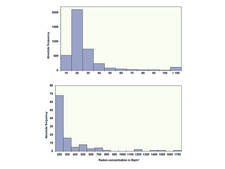-
Topics
subnavigation
Topics
Electromagnetic fields
- What are electromagnetic fields?
- Static and low-frequency fields
- Radiation protection relating to the expansion of the national grid
- High-frequency fields
- Radiation protection in mobile communication
Optical radiation
Ionising radiation
- What is ionising radiation?
- Radioactivity in the environment
- Applications in medicine
- Applications in daily life and in technology
- Effects
- What are the effects of radiation?
- Effects of selected radioactive materials
- Consequences of a radiation accident
- Cancer and leukaemia
- Genetic radiation effects
- Individual radiosensitivity
- Epidemiology of radiation-induced diseases
- Ionising radiation: positive effects?
- Risk estimation and assessment
- Radiation protection
- Nuclear accident management
- Service offers
-
The BfS
subnavigation
The BfS
- About us
- Science and research
- Laws and regulations
- BfS Topics in the Bundestag
- Links
Results of outdoor radon measurements in mining areas
- The annual levels of natural outdoor radon measured both all over Germany and in the mining areas of the New German Länder normally range between 5 and 30 bequerels per cubic metre and reach up to about 50 bequerels per cubic metre on rare occasions.
- Although radon concentrations significantly enhanced as compared to the background can occur in the vicinity of mining grounds (air shafts, dumps) in the areas of Saxony, Saxony-Anhalt and Thuringia characterised by intense old and uranium mining (the maximum measured level was 1,700 bequerels per cubic metre at the toe of a dump), there is no large-scale impact due to mining.
In the early 1990s, the Federal Office for Radiation Protection (Bundesamt für Strahlenschutz, BfS) started to operate measuring networks to determine radon concentrations (Radon-222) in the areas of Saxony, Saxony-Anhalt and Thuringia characterised by intense old and uranium mining.
The measurements were designed to assess the impact of mining activities and remediation of mining residues on natural radon. It was therefore necessary both to obtain an overview of radon concentrations in the affected areas and to determine natural radon concentration.
Results of the measurements performed by the BfS from 1991 to 2004

![]() Frequency distribution of annual values of outdoor radon concentrations assessed from 1991 to 2004
Frequency distribution of annual values of outdoor radon concentrations assessed from 1991 to 2004
Since outdoor radon concentrations vary greatly depending on the time of day and year, measurements over extended periods of time are required to gather reliable mean values. To this end, the BfS used a passive measurement system based on solid-state track detectors.
Within the scope of the measuring programme, 17 measurement networks were established to determine radon concentrations at 584 measurement points from 1991 to 2004. The figure opposite summarises all annual values of radon concentrations measured in residential areas.
In summary:
- The annual values vary greatly (from 5 to 1,700 bequerels per cubic metre); the maximum was measured next to the toe of a dump.
- Low concentrations were measured in most cases. For example, some 90 per cent of all annual values are below 40 bequerels per cubic metre.
- About one third of all annual values were between 10 and 15 bequerels per cubic metre, i.e. within a range typical of the natural background in Germany; where the mean radon concentration ranges from four to 31 bequerels per cubic metre.
- Enhanced levels of radon were measured only rarely (e.g. values exceeding 100 bequerels per cubic metre were only found in about one per cent of all cases).
Mining residues such as dumps, tailing ponds, air shafts, etc. turned out to affect outdoor radon concentrations only in the immediate vicinity. A large-scale impact on radon concentrations could not be established.
In most cases of mining facilities already remediated, the radon concentrations in adjacent residential areas were observed to decrease to the level of the regional background.
Enhanced levels of natural radon in the mining areas under study
Levels of natural radon concentration were determined at sites not affected by mining. Measurements yielded a mean of 16 bequerels per cubic metre with a standard deviation of 7 bequerels per cubic metre, where the annual values of natural radon concentration ranged from 5 to 50 bequerels per cubic metre.
The natural radon concentrations in the mining areas of Saxony, Saxony-Anhalt and Thuringia is somewhat higher than in most of the other areas of Germany, such as the North German Plain. This is mainly because the radium-226-content of soils and rocks in the mining regions is naturally enhanced and the atmosphere in valleys is often poorly mixed.
State of 2018.03.07


